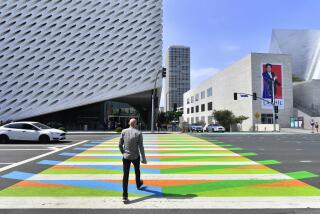Some public artworks in L.A. don’t credit artists
When Staples Center recently installed plaques and a pedestal inscription that provided artist credits previously missing from statues of sports greats outside its north entrance, it corrected a lapse in giving creative credit where it was due.
Affordability probably wasn’t an issue, given that Philip Anschutz, the arena’s majority owner, has a fortune that Forbes magazine recently pegged at $7.5 billion.
It’s different for Los Angeles, which is a far more serious delinquent when it comes to providing the names of artworks in the public realm and identifying their creators. About 250 public art installations are nameless, at least to residents who see them in person rather than looking them up on the publicartinla.com website — and the responsible party is the city government.
Felicia Filer, director of the Department of Cultural Affairs’ public art division, said recently that there’s no lack of will to comply with the city’s own policy mandating identifying plaques for public art. It’s the money that’s missing.
Public art in L.A. comes in two varieties — privately funded and city funded. When private developers build a nonresidential project valued at $500,000 or more, the law requires them to pay for artwork to adorn their sites or for cultural facilities immediately accessible to future employees at each site. Their art budget must be at least $1.57, $1.31 or 52 cents per square foot for offices, retail and hotels, respectively. For the city’s own construction projects, the arts tab is an additional 1% tacked on to the total construction cost.
Filer said that private developers routinely provide the mandated plaques because they are on a checklist that has to be completed as a condition of receiving an occupancy permit.
“The inconsistency is really on our end,” she said. “Sometimes we haven’t had the money for the plaques.”
Those “sometimes” now number about 250, she said, and it would cost at least $125,000 to $250,000 to install all the missing plaques.
A less expensive aluminum one runs from $500 to $1,000, Filer said; doing it up royally in bronze can cost $3,000 to $5,000. Some artists want the more expensive markers, she said, because it’s important to them to have a work in bronze matched by its plaque.
The rules say specifically that plaques must be paid for out of the budget of the Cultural Affairs Department, Filer said, rather than being piggybacked onto the construction budget. The department has been squeezed since 2004, when then-Mayor James Hahn floated a proposal to abolish it, then decided on deep cuts instead. Over the seven years, the core annual budget has fallen from $12.4 million to $7.7 million — a 47% reduction in inflation-adjusted arts spending.
With city officials contemplating further cuts to compensate for a recession-induced revenue shortfall of $350 million, it’s unlikely the department will be accumulating a stash for plaque purchases soon.
Los Angeles sculptor Peter Shelton says he recognizes the department’s budget woes and sympathizes with its plight, even as his “sixbeaststwomonkeys” remains plaque-less 17 months after its installation (the eight black figures in bronze outside LAPD headquarters along Spring Street were famously labeled “some kind of cow splat” by then-Chief William J. Bratton but were reviewed as “a procession of monumental, smartly abstracted animal forms” by Times art critic Christopher Knight.
“I can tell the cultural affairs department is having a hard time keeping up, and I’m hard-pressed to complain to them, because I know they’re really under the gun,” Shelton said. He’s less concerned about the lack of a plaque than with the city apparently having fallen behind on its obligation to clean and wax the work periodically to keep the bronze from turning green — a process he’s noticed has begun in spots. “Maybe I’ll end up having to suck it up and put my own plaque there at some point,” he said, “out of my own self-interest, and because it’s my city, and I would like people to be able to identify it and understand it a little bit.”
The rate at which the city has been falling behind on its plaque obligations has slowed considerably since the recession hit, but Filer says that’s no cause for celebration. It just means that the poor economy has put a damper on both public and private construction — so instead of the past norm of about 200 public art projects in the pipeline at a given time (split about evenly between government work and private development) there are only now 35 or 40.
More to Read
The biggest entertainment stories
Get our big stories about Hollywood, film, television, music, arts, culture and more right in your inbox as soon as they publish.
You may occasionally receive promotional content from the Los Angeles Times.







